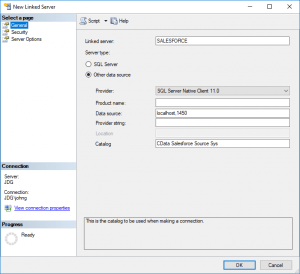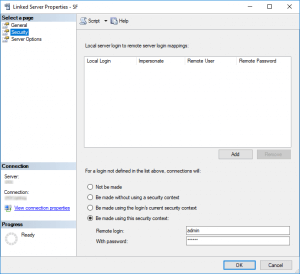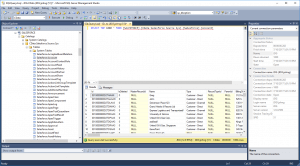The SQL Gateway enables you to configure a TDS (SQL Server) remoting service and set up a linked server for SAP HANA data.
After you have started the service, you can use the UI in SQL Server Management Studio or call stored procedures to create the linked server. You can then work with SAP HANA data just as you would a linked SQL Server instance. The CData SAP HANA drivers offer a data-centric model for SAP HANA that simplifies integration — allowing developers to build higher quality applications.
Connect to SAP HANA as an ODBC Data Source
If you have not already, first specify connection properties in an ODBC DSN (data source name). This is the last step of the driver installation. You can use the Microsoft ODBC Data Source Administrator to create and configure ODBC DSNs.
Set the Server, Database and Port properties to specify the address of your SAP Hana database to interact with. Set the User and the Password properties to authenticate to the server.
Configure the TDS Remoting Service
See the SQL Gateway Overview for a guide to configure a TDS remoting service in the SQL Gateway UI. The TDS remoting service is a daemon process that listens for TDS requests from clients.
Create a Linked Server for SAP HANA Data
After you have configured and started the daemon, create the linked server and connect. You can use the UI in SQL Server Management Studio or call stored procedures.
Create a Linked Server from the UI
Follow the steps below to create a linked server from the Object Explorer.
Open SQL Server Management Studio and connect to an instance of SQL Server. In the Object Explorer, expand the node for the SQL Server database. In the Server Objects node, right-click Linked Servers and click New Linked Server. The New Linked Server dialog is displayed.
In the General section, click the Other Data Source option and enter the following information after naming the linked server:
- Provider: Select the SQL Server Native Client Provider that corresponds to your version of SQL Server. For example, SQL Server Native Client 11.0.
- Data Source: Enter the host and port the TDS remoting service is running on, separated by a comma. Note that a value of "localhost" in this input refers to the machine where SQL Server is running so be careful when creating a linked server in Management Studio when not running on the same machine as SQL Server.
- Catalog: Enter the CData system DSN, CData SAPHANA Sys.

In the Security section, select the option to have the connection "made using this security context" and enter the username and password of a user you created in the Users tab of the SQL Gateway.

Create a Linked Server Programmatically
In addition to using the SQL Server Management Studio UI to create a linked server, you can use stored procedures. The following inputs are required:
- server: The linked server name.
- provider: Enter "SQLNCLI", for the SQL Server Native Client Provider.
- datasrc: The host and port the service is running on, separated by a comma. Note that a value of "localhost" in the datasrc input refers to the machine where SQL Server is running, so be careful when creating a linked server in Management Studio when not running on the same machine as SQL Server.
- catalog: Enter the system DSN configured for the service.
- srvproduct: Enter the product name of the data source; this can be an arbitrary value, such as "CData SQL Gateway" or an empty string.
Follow the steps below to create the linked server and configure authentication to the SQL Gateway:
Call sp_addlinkedserver to create the linked server:
EXEC sp_addlinkedserver @server='SAPHANA', @provider='SQLNCLI', @datasrc='< MachineIPAddress >,1434', @catalog='CData SAPHANA Sys', @srvproduct=''; GO
Call the sp_addlinkedsrvlogin stored procedure to allow SQL Server users to connect with the credentials of an authorized user of the service. Note that the credentials you use to connect to the service must specify a user you configured on the Users tab of the SQL Gateway.
Call the sp_addlinkedsrvlogin stored procedure to allow SQL Server users to connect with the credentials of an authorized user of the service. Note that the credentials you use to connect to the service must specify a user you configured on the Users tab of the SQL Gateway.
Call the sp_addlinkedsrvlogin stored procedure to allow SQL Server users to connect with the credentials of an authorized user of the service. Note that the credentials you use to connect to the service must specify a user you configured on the Users tab of the SQL Gateway.
EXEC sp_addlinkedsrvlogin @rmtsrvname='SAPHANA', @rmtuser='admin', @rmtpassword='test', @useself='FALSE', @locallogin=NULL; GO
Connect from SQL Server Management Studio
SQL Server Management Studio uses the SQL Server Client OLE DB provider, which requires the ODBC driver to be used inprocess. You must enable the "Allow inprocess" option for the SQL Server Native Client Provider in Management Studio to query the linked server from SQL Server Management Studio. To do this, open the properties for the provider you are using under Server Objects -> Linked Servers -> Providers. Check the "Allow inprocess" option and save the changes.
Execute Queries
You can now execute queries to the SAP HANA linked server from any tool that can connect to SQL Server. Set the table name accordingly:
SELECT * FROM [linked server name].[CData SAPHANA Sys].[SAPHANA].[Buckets]

Learn More
Companies everywhere are looking to leverage their data to make effective decisions and grow their businesses.
With the SQL Gateway and the ODBC Driver, you can set up a linked server for SAP HANA data. You can connect real-time SAP HANA data with BI, analytics, reporting, and data visualization technologies and seamlessly integrate with your favorite analytics tools.
Connect your RDBMS or data warehouse with SAP HANA to facilitate operational reporting, offload queries and increase performance, support data governance initiatives, archive data for disaster recovery, and more.

